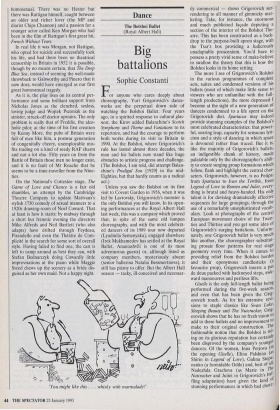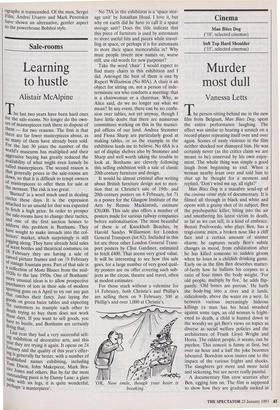Dance
The Bolshoi Ballet (Royal Albert Hall)
Big battalions
Sophie Constanti
For anyone who cares deeply about choreography, Yuri Grigorovich's dance- works are the perpetual down side of watching the Bolshoi Ballet. Four years ago, in a spirited response to cultural glas- nost, the Kirov added Balanchine's Scotch Symphony and Theme and Variations to its repertoire, and had the courage to perform both works during its visit to Britain in 1990. At the Bolshoi, where Grigorovich's rule has lasted almost three decades, the man and his ballets now stand like huge obstacles to artistic progress and challenge. (The Bolshoi, I am told, did attempt Balan- chine's Prodigal Son [1929] in the mid- Eighties, but that hardly counts as a radical act.) Unless you saw the Bolshoi on its first visit to Covent Garden in 1956, when it was led by Lavrovsky, Grigorovich's monster is the only Bolshoi you will know. In its open- ing performances at the Royal Albert Hall last week, this was a company which proved that, in spite of the same old lumpen choreography, and with the most celebrdt- ed dancers of its 1989 tour now departed (Lyudmila Semenyaka), engaged elsewhere (Irek Mukhamedov has settled at the Royal Ballet, Ananiashvili is one of its most adventurous guests) or, although listed as company members, mysteriously absent (senior ballerina Natalia Bessmertnova), it still has plenty to offer. But the Albert Hall season — tacky, ill-conceived and necessar- 'You might like this. . . whisky with marmalade!' ily commercial — shows Grigorovich sur- rendering to all manner of gimmicky mar- keting. Take, for instance, the enormous and much publicised facade depicting a section of the interior of the Bolshoi The- atre. This has been constructed as a back- drop to the purpose-built apron stage, with the Tsar's box providing a ludicrously unadaptable proscenium. You'd have to possess a pretty vivid sense of make-believe to swallow the theory that this is how the Bolshoi looks in its home setting.
The more I see of Grigorovich's Bolshoi in the various programmes of complete acts, suites and condensed versions of his ballets (most of which make little sense to viewers who are unfamiliar with the full- length productions), the more depressed I become at the sight of a new generation of dancers condemned to a life spent on the Grigorovich diet. Spartacus may indeed provide stunning examples of the Bolshoi's most celebrated characteristics: that power- ful, soaring leap, capacity for sensuous lyri- cism and a style of dancing in which space is devoured rather than traced. But it is, like the majority of Grigorovich's ballets, an indigestible chunk of history, made palatable only by the choreographer's abili- ty to create surging group formations which follow, flank and highlight the central char- acters. Grigorovich, however, is no Petipa: from Spartacus to Ivan the Terrible, from Legend of Love to Romeo and Juliet, every- thing is brutal and heavy-handed. His onlY talent is for devising dramatically effective sequences for large groupings, through the use of a remarkably unsophisticated vocab- ulary. Look at photographs of the central European movement choirs of the Twen- ties and Thirties and you get some idea of Grigorovich's surging battalions. Unfortu- nately, one Grigorovich ballet is very much like another, the choreographer substitut- ing prosaic floor patterns for real stage geometry every time. When it comes to providing relief from the Bolshoi hordes and their eponymous candlesticks (3 favourite prop), Grigorovich inserts a Pas de deux packed with hackneyed steps, awk- ward manoeuvres and perilous lifts. Giselle is the only full-length ballet being performed during the five-week season, and even that has been given the Grig- orovich touch. As for his extensive revi- sions to staple classics like Swan Lake, Sleeping Beauty and The Nutcracker, Grig- orovich shows that he has no fresh vision to add to these ballets and no improvement to make to their original construction. Tile fashionable notion that the Bolshoi is rid- ing on its glorious reputation has certainlY been disproved by the company's younger dancers. Of the women, Inna Petrova On the opening GI:wile), Elina Palshina Shirin in Legend of Love), Galina StePa- nenko (a formidable Odile) and, best of all, Nadezhda Gracheva (as Marie in Are Nutcracker and Juliet in Grigorovich's bar, fling adaptation) have given the kind co stunning performances in which bad chore'
ography is transcended. Of the men, Sergei Film, Andrei Uvarov and Mark Peretokin have shown an alternative, gentler aspect to the powerhouse Bolshoi style.



























































 Previous page
Previous page